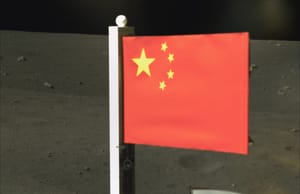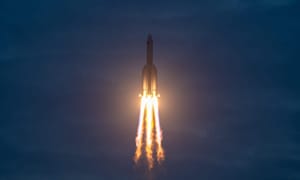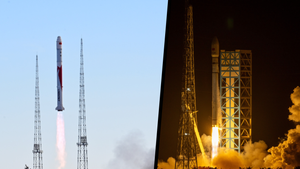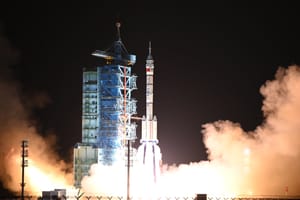
Oct 1, 2024
Top Five Greatest Achievements in China's Space Exploration Efforts
October 1st, 2024, is the day when the People's Republic of China turns 75! As such we'd like to celebrate by recapping what we believe to be some of the greatest achievements of China's space exploration efforts.
Before we begin do understand that this list is subjective, and your ranking may differ. With that out of the way, let's begin!
#5 - Chang'e 2

Starting the list off strong is Chang'e 2, which began its journey to the Moon on October 1st 2010 atop of a Long March 3C flying from the Xichang Satellite Launch Center. The mission entered lunar orbit on October 6th.
Chang'e 2's mission objectives around the Moon were to: demonstrate the orbital brake technology and capture by the Moon, perform technology tests on a 100-kilometer x 15-kilometer lunar orbit, capture high-resolution imagery of a possible landing area in the Sinus Iridum, test an X-band telemetry, tracking, and command measurement system, and finally to demonstrate the landing camera system ahead of Chang'e 3. Scientific objectives for the mission were: to obtain three-dimensional images of the lunar surface with a spatial resolution of less than 10 meters, explore the composition of lunar surface material, and to observe the Earth-Moon and near-moon space environment. All of the mission objectives were completed by November 8th 2010!
After completion of lunar mission objectives, the spacecraft departed for the Earth-Sun L2 Lagrange point in June 2011 and arrived a few months later on August 25th. Chang'e 2 became China's first spacecraft to enter the L2 point and remained there until the 15th of April 2012. Upon departing the L2 point Chang'e 2 began its journey toward asteroid 4179 Toutatis, which it arrived at in December 2012 making China the fourth nation to visit an asteroid. The closest Chang'e 2 came to 4179 Toutatis was 3.2 kilometers.
Contact with Chang'e 2 was lost in 2014 due to its distance from Earth, but it could return around 2027. Despite this Chang'e 2 thoroughly tested China's deep space communications capabilities ahead of further lunar and deep space missions.

#4 - Tianwen-1

It's difficult not to mention the Tianwen-1 mission due to the incredible strides in deep space exploration the mission represented. Tianwen-1 was the nation's first mission to the red planet and consisted of an orbiter, a lander, and a rover. Each one of the mission's major elements would have been an impressive feat by itself, but completing them all in one represented a major leap in China's capabilities for deep space exploration.
Objectives for the Tianwen-1 mission were: to study the characteristics of the Martian topography and geological structure, to study the characteristics of the soil on the Martian surface and the distribution of water ice, to investigate the substance composition of the Martian surface, to study the ionosphere, surface climate and environmental characteristics of Mars, and lastly to study the Martian physical fields (electromagnetic, gravitational) and internal structure.
Tianwen-1 began its voyage to Mars from the Wenchang Space Launch Site on July 23rd 2020 atop of a Long March 5. The orbiter brought the orbiter-lander-rover combination into Mars orbit in February 2021. Over the next three months, the spacecraft surveyed the planet's surface ahead of committing to a landing. This landing occurred on May 14th, bringing the lander and Zhurong onto the surface.
Zhurong rolled onto the surface of Mars on May 22nd beginning its trek across the surface. The rover spent a year exploring the red planet's surface, traveling almost two kilometers. Sadly due to dust accumulation on the solar panels, Zhurong ran out of power and has been in 'hibernation' since the middle of 2022. Tianwen-1's orbiter remains in Mars orbit to this day conducting science and imaging Mars.

#3 - Chang'e 5 & Chang'e 6

The twin spacecraft Chang'e 5 and Chang'e 6 are hard not to mention, having returned the newest lunar samples in fifty years. Both missions utilized a combination of an orbiter, a re-entry capsule, a lander, and an ascent vehicle.
The orbiter allows the entire spacecraft to enter lunar orbit; the lander allows it and the ascent vehicle to travel down to the lunar surface to collect surface samples; the ascent vehicle carried the samples from the surface into lunar orbit where it rendezvoused with the orbiter; and the re-entry capsule allowed the lunar surface samples to survive re-entry and touchdown back on Earth.
Chang'e 5 conducted its mission between November and December of 2020 landing near Mons Rümker in the north of Oceanus Procellarum. The spacecraft's return capsule touched down on Earth with 1,731 grams of samples on December 16th. These samples led to the discovery of the material Changesite-(Y), a phosphate mineral in the merrillite group, which also contains the rare helium-3 isotope.
Chang'e 6 conducted its mission a few years later, between May and June 2024 landing in the Apollo Basin, which itself is in the lunar South Poles Aitken basin, on the Moon's far side. The spacecraft's return capsule came back to Earth with 1,953.3 grams of Samples on June 25th.
Both missions brought China's Lunar Exploration Program to the forefront of unmanned exploration of Earth's closest neighbor in the universe.
#2 - Tiangong Space Station

China's Tiangong Space Station is a technological marvel in low Earth orbit, being one of two permanently crewed space stations. Construction of the space station in orbit began in April 2021 and was completed in October 2022. The space station consists of the Tianhe core module, the Wentian laboratory module, and the Mengtian laboratory module. With visiting Shenzhou and Tianzhou spacecraft, the station weighs approximately 100,000 kilograms.
Various types of science are performed aboard the space station in fields such as ecology, biotechnology, material science, combustion science, the effects of microgravity, and how the human body adapts to life in space. In between the conducting science, crews aboard Tiangong enjoy various types of food including fruit, vegetables, pre-prepared food, and hot meals using their microwave, which is the first of its kind in space.
To date, the space station has been visited by seven crews and six cargo spacecraft. The Tiangong Space Station is expected to remain inhabited by at least a crew of three until the mid-2030s.

Honorable Mentions
In addition to the mission so far, and ahead of what is number one, there are of course some honorable mentions due to how many pioneering missions China has flown in the past two decades.
Chang'e 3 & Chang'e 4

The Chang'e 3 and Chang'e 4 spacecraft twins blazed a path back to the Moon for exploration of the lunar surface, and are well deserving of a mention as such.
Chang'e 3 became the first time China would land a spacecraft on the lunar surface, becoming the third nation to do so and the first mission since 1976. The mission launched back on December 1st 2013 atop of a Long March 3B and would land almost two weeks later on December 14th. On the surface, Chang'e 3 would deploy the Yutu rover as well as conducting experiments related to Earth observation, astronomy, and probing of the lunar regolith.
Chang'e 4 is China's first mission to the Moon's far side, as well as the first mission to do so in history. This mission launched back on December 7th 2018, also atop of a Long March 3B, and would land almost a month later on January 3rd 2019. Chang'e 4 would begin its surface mission shortly after landing, including deployment of the Yutu-2 rover, to conduct science experiments related to solar weather monitoring, plant growth in lunar gravity, and sub-surface activity. The Chang'e 4 spacecraft is also still operating on the lunar surface today, expanding our understanding of the much lesser explored far side.
Shenzhou-9

The Shenzhou-9 mission to the Tiangong-1 space station was the first time a Chinese woman flew into space, as well as the first repeat flight of a taikonaut, along with the first crew to visit China's first space station. Shenzhou-9's crew were Jing Haipeng (景海鹏), the first repeat flyer, Liu Yang (刘洋), the first Chinese woman in space, and Liu Wang (刘旺).
The Tiangong-1 space station was launched on September 29th 2011, with the Shenzhou-9 crew launching on the 16t June 2012, and docking on the 18th. While aboard the station for almost eight days, the crew conducted experiments, tested station systems, and performed two docking tests with their Shenzhou spacecraft.
Shenzhou-7

The Shenzhou-7 mission was another major human spaceflight mission as it saw the first spacewalk by a taikonaut. This spacewalk was performed by Zhai Zhigang (翟志刚) from the orbital module of the Shenzhou-7 spacecraft. Also onboard the for the mission were Liu Boming (刘伯明), in a Russian Orlan spacesuit to support Zhai from inside the orbital module, and Jing Haipeng (景海鹏), inside the capsule taking care of the spacecraft.
The primary goal of the Shenzhou-7 mission was to demonstrate the capabilities of the first-generation Feitian space suit by leaving the spacecraft and retiring an experiment that had been running outside. This experiment was a solid lubricant that had been exposed to the vacuum of space for forty hours. A satellite, weighing 40 kilograms, was also deployed from the spacecraft following the spacewalk to image the Shenzhou-7 spacecraft and prove 'mini-satellite' technology.
#1 - Shenzhou-5

October 15th 2003 is a day that will live on forever in China's space industry as it was the first time the nation conducted a human spaceflight mission, becoming the third to do so. Taikonaut Yang Liwei (楊利偉) flew onboard the Shenzhou-5 spacecraft for the historic mission.
Shenzhou-5 spent twenty-one hours, twenty-two minutes, and forty-five seconds in orbit, completing fourteen orbits, demonstrating China's ability to send humans into orbit and return them safely. During his time in orbit, Yang Liwei ate various meals, took photos looking around and out of the spacecraft, spoke with his family, napped, and monitored how he felt adapting to space for mission controllers.
Following his flight, Yang received the title of 'Space Hero' from then-outgoing paramount leader Jiang Zemin (江泽民), the Gagarin Medal from Russia, and an honorary doctorate from the Chinese University of Hong Kong. Yang Liwei is currently working as deputy chief designer of the China Manned Space Engineering Office.
The orbital module for the Shenzou-5 mission was detached before a deorbit burn to perform various experiments, with staying in orbit until the 30th of May 2004.

What are taikonauts?
The word taikonaut has been used in this article so a small explanation of the word is necessary for those unfamiliar with it. Taikonaut is what China calls its astronauts. It comes from a combination of the Chinese word for outer space, taikong, and the suffix, naut.
A similar post was written for the United States on July 4th, in line with our mission this article was written too.



